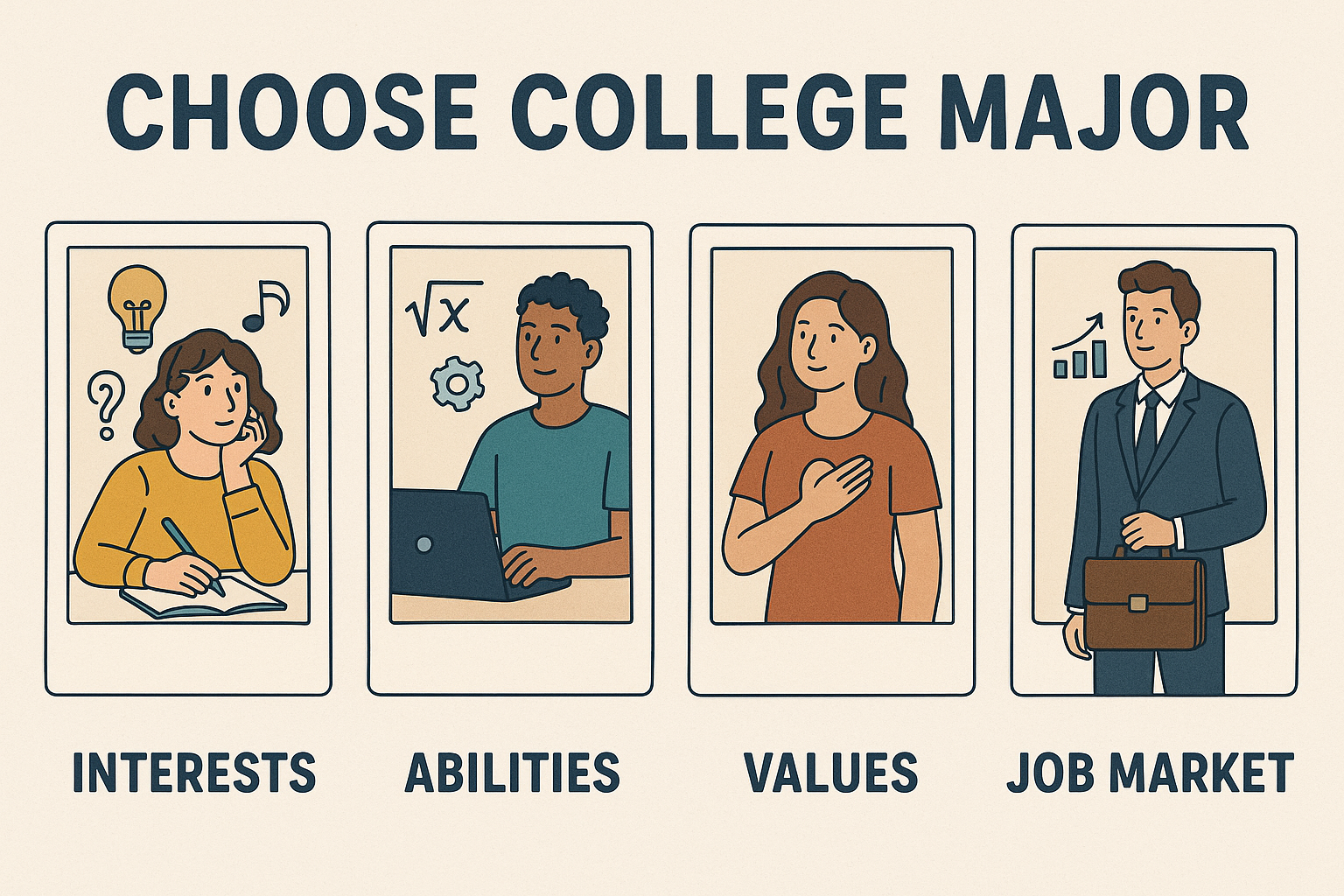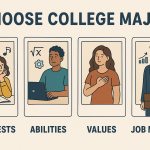Career News
How to Choose Your College Major with Assessment

Scene: Virtual coaching session choosing college type & major between Jordan (high-school senior) and Casey (Certified Admissions & Motivation Coach).
1 | Start with why, not ranking
Jordan: I keep hearing that the best-ranked colleges guarantee success.
Coach Casey: Rankings are just billboard glitter. Your long-term success is driven by fit and fit begins with understanding your core motivations.
2 | Saturday: take the FREE MAPP Assessment
Coach Casey: Block a distraction-free hour this Saturday. Go to Assessment.com and spend 15 minutes to take the MAPP Assessment.
- 71 motivational variables measured
- Instant PDF with your Top Motivators, Ideal Career Families, and Work Environment Preferences
Print the report, highlight phrases that repeat“ project ownership,” “idea generation,” “mentoring,” etc. These words are clues to majors that will energize you for four years.
3 | Translate MAPP drivers into major criteria
| MAPP Motivator | Majors / Academic Models That Match |
| High Conceptual Thinking | Research-heavy STEM, Philosophy, Data Science honors tracks |
| Need for Social Impact | Public Health, Social Entrepreneurship, Environmental Policy |
| Autonomy & Quick Pace | Self-designed majors, co-op engineering, accelerated BS/MS |
| Preference for Concrete Results | Industrial Design, Construction Management, Nursing |
| Drive for Artistic Expression | Animation, Creative Writing, Music Technology |
Create a two-column document: Motivator → Major Characteristics. This becomes your personal search rubric.
4 | Build your College-Major Fit Matrix
- Add 25 potential colleges down the left.
- Put 6–8 motivator-based criteria across the top (research access, service-learning, flexible curricula…).
- Score each school 1-5 for every column.
- Only after scoring should you glance at prestige metrics; use them as tie-breakers, not gatekeepers.
5 | Deep-dive into curriculum design
Ask admissions reps or faculty:
- “How soon can first-years join a research lab?”
- “Are capstone projects mandatory?”
- “Is grading curved or mastery-based?”
Match answers to your MAPP profile. For instance, if your report flags low external competition, curved grading might sap motivation opt for mastery-based programs instead.
6 | Culture & vibe check (beyond the brochure)
- Reddit & Discord: read unfiltered student threads.
- LinkedIn Alumni: filter by your potential majors; message three recent grads.
- TikTok/Instagram: Day-in-the-life content reveals energy cycles, study habits.
Rate each insight against your motivators do you thrive in bustling social hubs or quiet makerspaces?
7 | Reality tests your top picks
| Touchpoint | What to Observe | Fit Signal |
| Shadow a Class | Teaching style | Does it match “Independent Inquiry” motivator? |
| Overnight Dorm Stay | Social rhythms | Aligns with “High Sociability” or “Need for Quiet”? |
| Department Info Session | Faculty attitudes, lab tours | Support for “Hands-on Projects” motivator? |
Take notes immediately; memory glamorizes later.
8 | Decision triangle Motivation, Major, Money
Visualize a triangle:
- Motivation Fit (MAPP score)
- Major Quality (department strength)
- Financial Feasibility
The optimal choice sits near the centroid. If one point stretches too far say, perfect major but motivation mismatch the triangle tips.
9 | Keep fit dynamic
Motivation evolves. Retake the MAPP midway through sophomore year:
- Adjust electives or minors.
- Choose internships that map to any new top drivers.
Quick 48-hour Action Plan
- Take the FREE MAPP Assessment (Assessment.com).
- Print & highlight top drivers.
- Send me the report; Monday we’ll start your College-Major Fit Matrix.
Jordan: This feels way more personal than chasing league tables.
Coach Casey: Exactly. The “best” college major type is the one that amplifies your internal compass let’s build around that.
NEXT: Choosing your actual MAJOR
How to Use Your MAPP Assessment to Pinpoint the College Major You’ll Love and Thrive In
Below is a practical, five-step workflow I use with students. I’ll walk you through the method and illustrate it with a sample MAPP profile, complete job-market data, earnings, and career titles.
STEP 1 | Take MAPP & Pull Out Your Top “Career Families”
After finishing the free MAPP on Assessment.com you’ll see a section called “Job Family Compatibility.”
Pick the top 3–5 families (those in the Very High or High compatibility zones).
Sample result
- Analytical Research & Information Systems
- Quantitative Problem Solving
- Conceptual/Innovative Design
These clusters tell us why work feels rewarding to you not just what you’re good at.
STEP 2 | Translate Career Families → College Majors (you can you the ai assistant just ask the questions..)
| MAPP Career Family | Typical Major(s) | Why the Match Works |
| Analytical Research & Info Systems | Data Science, Statistics, Computer Science | High need for pattern discovery, independent analysis |
| Quantitative Problem Solving | Applied Math, Economics, Actuarial Science | Strong drive to resolve numerical puzzles, model scenarios |
| Conceptual / Innovative Design | Industrial Design, Human-Computer Interaction | Preference for open-ended ideation and prototyping |
Make a short-list of 3 majors whose course work naturally exercises your dominant motivators.
STEP 3 | Validate Each Major with Job-Market Facts
Below is a deep-dive for Data Science (the sample student’s top match).
(Figures come from the U.S. Bureau of Labor Statistics 2024–2025 projections.)
| Metric | Data Scientist | Data Analyst | Machine-Learning Engineer | Actuary (alt-path) |
| SOC Code | 15-2051 | 15-1241 | 15-2051 (ML subset) | 15-2021 |
| Median Annual Pay (2023) | $108,000 | $79,400 | $126,000 | $114,000 |
| Job Growth 2022-32 | 35 % (much faster) | 23 % | 35 % | 23 % |
| Typical Entry Degree | B.S. Data Science / CS | B.S. Statistics / Biz Analytics | B.S.+ projects | B.S. Math + exams |
| Daily Motivators Hit | Pattern discovery, autonomy, high impact | Reporting, collaboration | Innovation, complex problem-solving | Probability modeling, risk puzzles |
Quick read: All four roles tick the Analytical-Research + Quant-Problem drives revealed in the MAPP profile and carry strong growth & earnings.
STEP 4 | Rank Colleges by Motivator Fit + Market Outcomes
Create a simple spreadsheet:
College Research Access Data-Sci Curriculum Co-op / Internship Cost Net Motivator Fit Score
---------------------------------------------------------------------------------------------------------
University A 5 5 4 $$ 93
University B 3 4 5 $ 88
...
- Give each column a weight:
- Motivator Fit (40 %) – Does the program promise hands-on analytics, independent projects, faculty data labs?
- Career Outcomes (30 %) – 6-month placement rate, mean starting salary.
- Cost / Aid (30 %) – Net price after scholarships.
The numeric total reveals which program balances passion and payoff.
STEP 5 | Lock the Decision with Micro-Experiences
- Shadow a sophomore data-science lab – See if the day-to-day work sparks the same motivation buzz you felt during MAPP.
- Interview two alumni – Ask how often they use the skills that excited you in Step 2.
- Run the “Motivation-Major-Money Triangle” check – Does the college still sit near the centroid when you plot those three forces?
- Retake MAPP after freshman year – Motivations evolve; if scores shift, pivot electives or even minors early.
Putting It All Together
Ability tells you what you could do; motivation predicts what you’ll keep doing when the honeymoon ends.
The MAPP report hands you the raw data. Mapping those drivers to specific majors, then cross-checking with employment outlook and compensation, turns guesswork into a high-clarity plan:
- MAPP → Career Family
- Career Family → Major(s)
- Major → Concrete Job Titles + Earnings
- College Short-list → Motivator Fit Matrix
- Decision → Live Tests & Financial Reality
Follow the loop and you’ll choose a degree path that keeps you energized and employable long after orientation week swag is forgotten.





